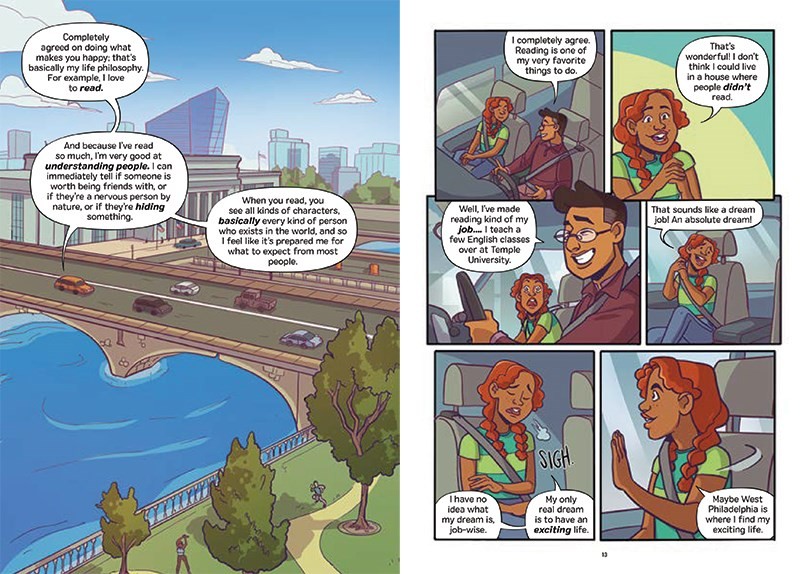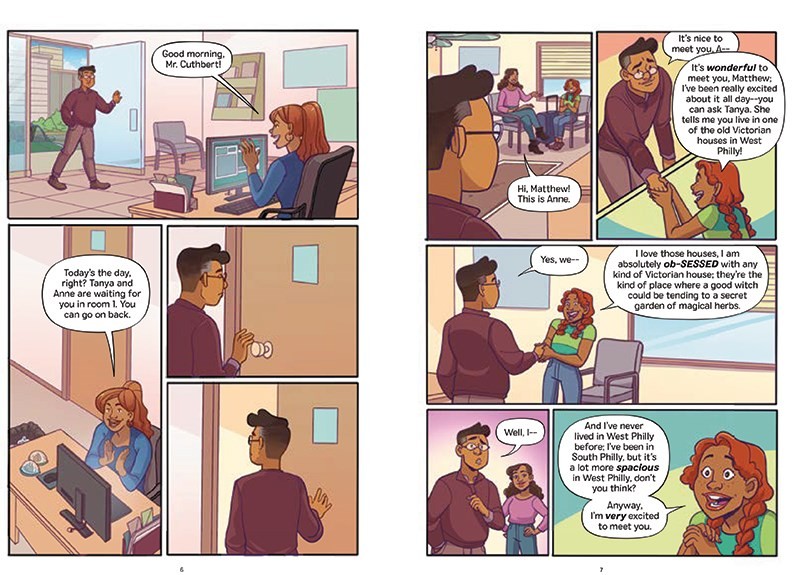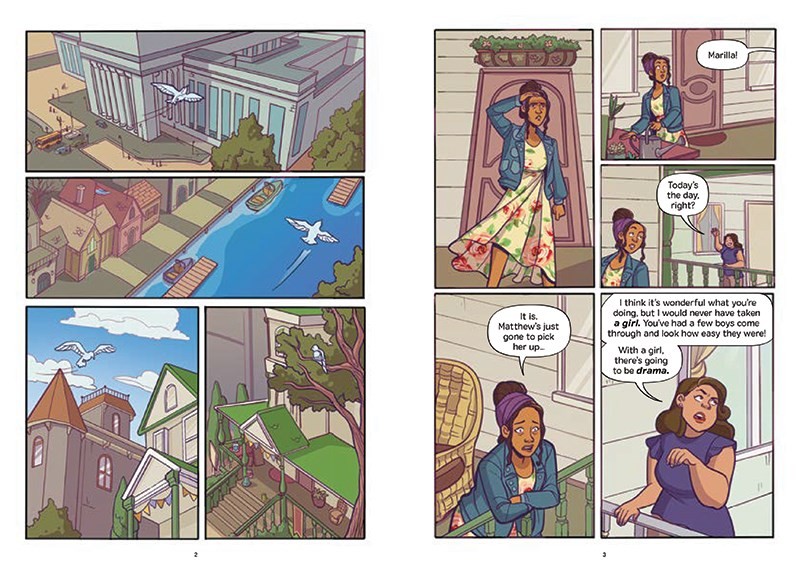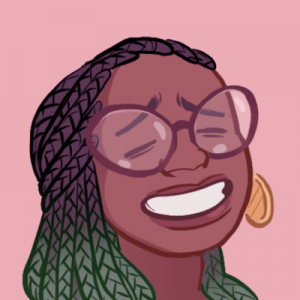Anne of Green Gables gets a modern, and more than welcome, upgrade in the latest graphic novel from Ivy Noelle Weir and Myisha Haynes.
Anne of Green Gables with a twist: in this follow-up to Meg, Jo, Beth, and Amy and The Secret Garden on 81st Street, this full-color graphic novel moves Anne Shirley to modern-day West Philadelphia, where she finds new friends, new rivals, and a new family.
When Marilla and Matthew Cuthbert decide to foster a teenage girl for the first time, their lives are changed forever. Their redheaded foster daughter, Anne Shirley, is in search of an exciting life and has decided that West Philly is where she’s going to find it. Armed with a big personality and unstoppable creativity, Anne takes her new home by storm as she joins the robotics club, makes new friends in Diana and Gilbert, experiences first love, and turns the ordinary into the extraordinary. But as Anne starts to get comfortable, she discovers one thing she wasn’t looking for: a family.
Review
Yes, Ivy Noelle Weir continues her trend of effective graphic novel re-telling’s with Anne of West Philly, this time tackling the beloved Canadian classic, Anne of Green Gables written by Lucy Maud Montgomery in 1908, and as expected, the similarities to the source material are very clear and present. From the names and disposition of the characters to Anne’s intransigency that her name should always be spelt with an “e”, the beats and rhythms will be recognizable to any Gabler™. So, what’s the point then of this or any re-telling, and will having any familiarity with the source material influence your reading experience?
Addressing the latter, unless you’re some eccentric AoGG purist, then the answer is no. I’ve never read the Montgomery novel in any formal way and enjoyed this story just fine, certainly being a fan of re-telling classics to fit a more modern sensibility helps. As for the former, the point is exactly that, to grab a classic story by the collar, one that has strong themes, and update it to reflect the world we see outside our window. Because I don’t think I need to tell you that there are significant differences between Prince Edward Island in 1908 and Philadelphia in 2021.
Gone is the blinding whiteness and vapid rural setting, in its place is a multi-racial cast and a vibrancy infused West Philadelphia. And there are a few story changes besides the contemporary melting-pot and aesthetics, those occur near the end of the book, but I won’t be going there. All I’ll say is that the ending more reflects the overall tone and mood of this updated version, not to mention the advantages of modern medicine and having an economic social safety net. What I want to talk about mostly is second chances and how quick we are to quit on a child/teen because they are deemed “problematic” or “difficult”. And I won’t gender-focus the issue, but it is a fact that girls are much more likely to be affixed these dangerous labels rather than boys. But in reality, and in either case, what they’re experiencing is an intense eagerness to please, variable and rapid highs and lows, and fear, all trauma induced. And I know what you’re thinking, that makes an awful lot of us “problematic” as well doesn’t it? Yes, it sure does.

I’ve always taken the decision to have kids very seriously, it’s why I don’t have any, and it amazes people that I’m so preoccupied with their well-being. But the fact is I’m relying on the next generation, and the generation after that, to continue the fight for equality and justice, to continue to hope. Unfair? Maybe. But I also know that this is the same hope that brings so many kids into this world in the first place, the hope that their kids will live a life less-ordinary than their own. This is the same dangerous presupposition that can result in neglect or worse. And along with a multitude of other factors, including socio-economic and systematic racial and class warfare, this is what lands a kid(s) in the foster system more often than not.
So, it should go without saying that the primary purpose of foster care is to provide a safe and stable short-term living environment for a child/teen in need of one, hopefully that’s a given. But even us non-parents know there’s more to it than that when it comes to ensuring the well-being and needs of a child are met in the long-term, or before they age out. And of all the responsibilities a foster parent(s) has (it’s a long list), these two strike me as being significant…
“…to encourage and support the foster child’s participation in school activities, leisure time activities, community activities and his/her own interests.”[1]
…and…
“Foster homes teach children what it means to be a kid. They learn to laugh and love and to act their age.”[2]
An unfortunate by-product of being bounced around is that age becomes a construct, with the convenience of childhood being replaced by experiencing the same stresses and ailments as adulthood. Already our Anne has had to play the role of “parent” to some younger children in a previous placement, sure, providing some experience in that regard, but also furthering her confusion about roles and responsibilities, and what’s expected from a kid. I’ve ranted about this before covering other books, but it strikes me as a grave injustice, when a kid is old before their time, being denied that youthful expression that is vital in living on this planet we call Earth. And smartly, Ivy doesn’t hit you over the head with this fact, nor does she offer the direst of circumstances either, rather taking a subtler more meaningful approach. It’s good stuff.
Yes, Anne is a kid, something she’s forgotten along the way, or it’s been driven out of her from a system that is underfunded and overburdened. To disentangle this, there’s a small but tender moment early on as Marilla explains to a flustered Anne that she doesn’t have to take care of anyone anymore, those days are over, that she can just be a kid. That’s a revelation for Anne and something so many of us have taking for granted at one time or another, being allowed and afforded the opportunity to simply act our age. So, it’s no surprise that two things the Cuthbert’s reinforce/encourage almost immediately with a well-travelled Anne, are her obligations as a kid, and that her passions aren’t necessarily reliant on circumstance anymore, they are not mutually exclusive. Listen, it’s hard to care about anything when you know certain doors will just never be open to you, or that you’ll never be able to afford or facilitate any passions or hobbies. But, and I mean especially with kids, we should believe in the value of opportunity and second chances, heck, even third, fourth, and fifth chances. Because people can and do change and we shouldn’t be burdening kids with the weight of mistakes they didn’t make in the first place.

How many kids will never know their potential or be a contributor because of unfortunate events or a system that has failed them? Anne is indeed bursting with creativity and genius, but most of us are a product of three things, nature, nurture, and environment, and she hasn’t had all three for some time, maybe not ever, in the affirmative. So, both Marilla and Matthew, seasoned foster parents, know that for a kid to blossom, to succeed, they need support and opportunity, and the Cuthbert’s offer both. But reversing the illusory truth effect is no easy task and guess what, foster parents aren’t perfect either, this includes these two who make mistakes along the way. But instead of the damn breaking or affixing a return to sender label, something Anne expects to happen, these turn into learning opportunities for both sides. The scenes between Anne and Marilla in particular, two deceptively beguiling women, are wonderfully written and I can’t help but feel Ivy saved her most precious words for them.
Anne, like most foster kids I’d imagine, lives in a perpetual state of limbo, with fear and anxiety being not-so-strange bedfellows, leading to behavioral issues as one would expect. The result of all this, is we keep waiting for her to screw up, again, blowing another opportunity at finding some sort of permanent placement, the gold at the end of the foster kid rainbow. And of course, it all makes sense, because that’s what she’d been groomed to do, she’s been conditioned to react with fear and anger. And when it came time to be placed in yet another home, she did exactly what she’d been expected to do…mess it up, even one of her less-supportive new “friends” says as much. But luckily for Anne, this isn’t the usual placement, and the unconventionality of Marilla and Matthew Cuthbert, not to mention their gentle disposition, has a few things in store for her, making this conclusion anything but forgone.
As for the “graphic” side of this graphic novel, Ivy brings along Myisha Haynes for the ride and the combination of Ivy’s words and Myisha’s art works very well. This might be Myisha’s first graphic novel but it’s not her first publishing experience, having amassed a nice portfolio in only five years. And using a wide-ranging palette and wonderfully expressive faces, Myisha’s art fits in alongside seamlessly with Ivy’s words, making this graphic novel experience a good one, often great. It’s the little uncomplicated details that will jump out at you, ensuring Anne’s famously red hair stands out on each panel she’s in (even when she does the unthinkable…haircut!), or reflecting the changing seasons, yes, this novel is as much a pleasure to look at it as it is to read.
Yes, the City of Brotherly Love homers will be pleased I imagine as both Ivy and Myisha treat the city with a certain degree of reverence, turning what I assumed to be a hollow grey jungle into a kaleidoscope of sights, sounds, and people. While not a character the way New York was in her previous book, The Secret Garden on 81st Street, you definitely get a clear picture of what makes this particular part of Philly, playing more like a reveal than a makeover, a special place.

So, what’s the bottom line?
The purposely breezy format carries with it a certain heaviness, as you feel the weight of the world on the shoulder’s of the Cuthbert’s and Anne. We don’t get any details per se, but like Anne, Marilla and Matthew are the result of a lived experience, finding comfort in the spectrum of existence, a life based on their own terms. It’s a near-perfect situation for Anne who herself is learning that we all have something unique to offer the world.
As for the story, the messaging is relevant and on point and the casually diverse cast provides representation without being preachy. It’s a lot of us like to call, “normal”. And because Ivy toys ever so slightly with the predictability of the original, the last panel is as important as the first. Yes, just like Ivy’s other re-telling’s, my hope is that this will be the definitive version of another tired old classic for this new and future generations.
And dare I say this responsibility is in no better hands?
To order a copy of Anne of West Philly, click HERE!
About the Author/Illustrator:

Ivy Noelle Weir is a writer of comics and prose. She is the co-creator of the Dwayne McDuffie Award-winning graphic novel Archival Quality (Oni Press), the upcoming The Secret Garden on 81st Street (Little, Brown for Young Readers), and her writing has appeared in anthologies such as Princeless: Girls Rock (Action Lab Entertainment) and Dead Beats (A Wave Blue World). She lives in the greater Boston area with her husband and their two tiny, weird dogs.

Myisha Haynes has worked in the Bay Area as a games and marketing artist for 4+ years. When not working in her spare time on her fantasy webcomic, The Substitutes, Myisha spends her remaining hours decorating her house with superheroes and coveting other people’s pets. She’s also worked for Marvel’s Gwenpool, and has published a comic in the Eisner & Ignatz-winning Elements Anthology: Fire and done cover work for Lion Forge’s Castoffs.
[1] https://gov.mb.ca/
[2] https://adoption.org/

